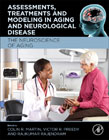
Assessments, Treatments and Modeling in Aging and Neurological Disease: The Neuroscience of Aging
Martin, Colin R.
Preedy, Victor R.
Rajendram, Rajkumar
Assessments, Treatments and Modeling in Aging and Neurological Disease: The Neuroscience of Aging is a comprehensive reference on the diagnosis and management of neurological aging and associated disorders. The book discusses the mechanisms underlying neurological aging and provides readers with a detailed introduction to the aging of neural connections and complexities in biological circuitries, as well as the interactions between genetics, epigenetics and other micro-environmental processes. It also examines pharmacological and non-pharmacological interventions of age-related conditions that affect the brain, including Alzheimer's, stroke and multiple sclerosis. Provides the most comprehensive coverage of the broad range of topics related to the neuroscience of aging Features sections on diagnosis and biomarkers of neurological aging, Alzheimer's and stroke Contains an abstract, key facts, a mini dictionary of terms, and summary points in each chapter Focuses on neurological diseases and conditions linked to aging, environmental factors and clinical recommendations Includes more than 500 illustrations and tables INDICE: I. Introductory chapters: Setting the scene for the neuroscience of aging 1. The concept of productive aging 2. Quality of life in the over 80s 3. Successful aging and diet 4. The impact of positive social relations on the quality of life of older people. An alternative to medicalization from an integral perspective 5. The brain in life span: Use of phase fMagnetic Resonance Imaging (MRI) 6. Neuronal structure in aging: cytoskeleton in health and disease 7. Sporadic Alzheimer's Triad: Age, Sex, and ApoE 8. How polymorphisms impact: BDNF polymorphism, inhibitory performance and the elderly 9. Menopause as an aging process and alcohol misuse 10. Brain banking and aging II. Impairments and Diseases 11. Dementia or no dementia in the very elderly. Why? 12. Neuropsychology, Social Cognition and Loss of Insight in Frontotemporal Dementia 13. Neuroinflammation in the elderly 14. Cortical microinfarcts and the aging brain 15. Vascular brain injury and neurodegeneration in elderly racial and ethnic minority populations 16. Hearing loss amongst the elderly 17. Aging Auditory Cortex: The Impact of Reduced Inhibition on Function 18. Aging and vestibular disorders 19. Brain aging in HIV and antiretrovirals 20. Antioxidants, Methylmercury, and Aging 21. Aging and the effects of ethanol on the brain: Comparing the effects of different aging III. Biomarkers and Diagnosis 22. Aging brain: Radiological biomarkers 23. Plasma ADAM10 as a biomarker of mental impairment in the elderly 24. Circulating microRNAs as biomarkers of healthy elderly 25. DHEA as a biomarker of aging in humans and nonhuman primates: Synthesis, neuroprotection and cognitive function 26. Evaluation of subjective memory abilities in elderly people 27. The Functional Activities Questionnaire: Applications to aging 28. Autobiographical memory as a diagnostic tool in aging 29. Assessment tools for subjective memory abilities in elderly people 30. Knowledge of Memory Aging IV. Management and Treatments 31. Pharmacological use of transient receptor potential (TRP) ion channel antagonists in neurological disease: Effects on swallowing and implications for nutrition 32. Aripiprazole: Features and use in the aged 33. Cognition-Enhancing Drugs and Applications to Aging 34. Creatine supplementation and impact on the aging brain 35. Photobiomodulation as a brain-boosting strategy in aging 36. Innovation in deep brain stimulation in aging: a focus on Parkinson Disease 37. Exergames: What they are and how they can be used to improve cognition in aging 38. Linking cognitive decline and ballroom dance as a therapeutic intervention in the elderly 39. Active experiencing training in the elderly 40. Psychiatric self-management, smartphone apps and older adults 41. Psychosocial Interventions for Suicide Prevention in the Elderly: Advances and Future Directions V. Models and Modelling 42. D-galactose-induced aging and brain mitochondria 43. Drosophila as a model organism in ageing research 44. The Zebrafish (Danio rerio) and its uses for understanding the neuroscience of aging: applications and observation 45. Murine models of primary Tauopathy as a model of aging 46. Modelling nutrition and brain aging in rodents 47. Modelling primates and neurological aging: A focus on Alzheimer's disease 48. Linking aging and animal models to neurodegeneration: The Striatum, Substantia Nigra and Parkinson's Disease 49. Behavioral evaluation of aging VI. Resources 50. Research and recommended resources in the neuroscience of aging
- ISBN: 978-0-12-818000-6
- Editorial: Academic Press
- Encuadernacion: Cartoné
- Páginas: 606
- Fecha Publicación: 12/07/2021
- Nº Volúmenes: 1
- Idioma: Inglés
